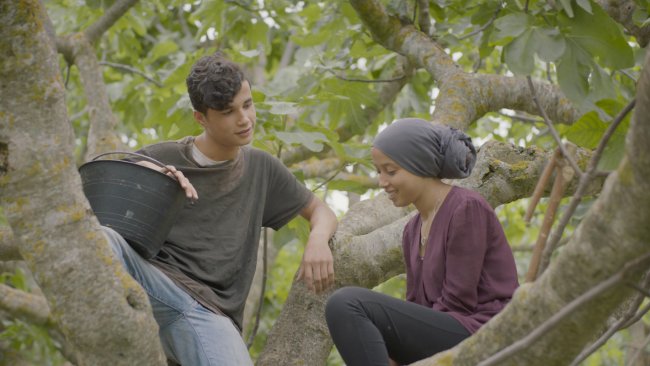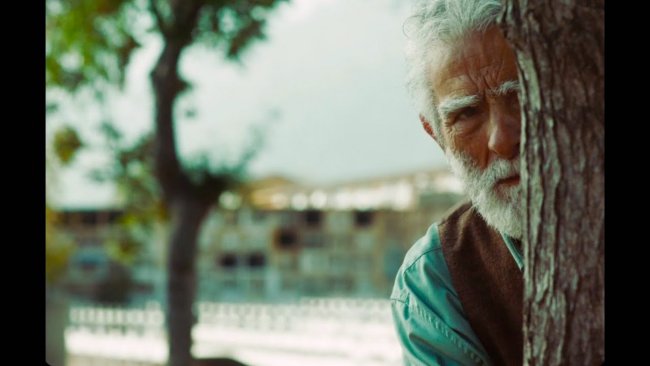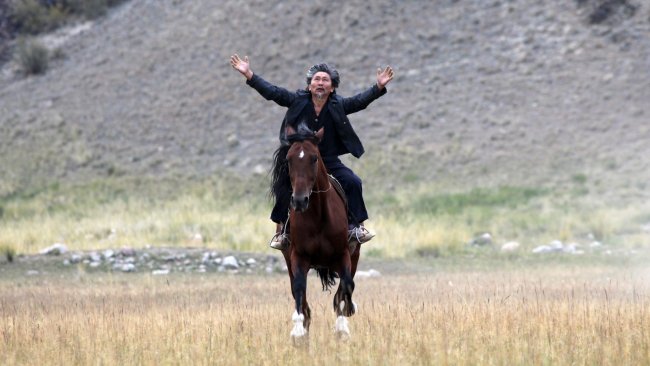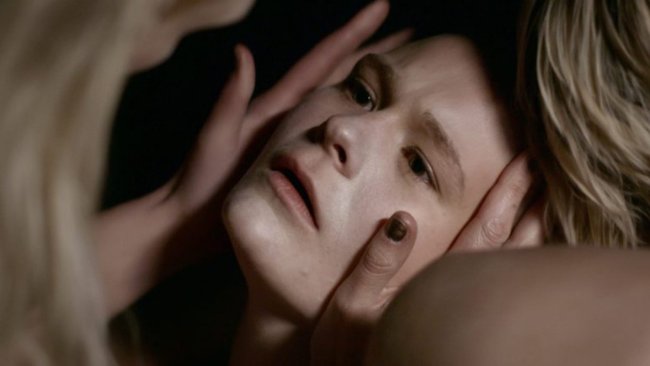Viennale and the Architecture of Cinephilia
A filmic journey to Vienna in four episodes
1. Home for cinephiles, room for transcendence
2. Meeting Eva Sangiorgi
3. How (not) to forget – or The art of forgetting
4. From monumentalism to Geographic Cinema, to Walking Cinema
Text: Giuseppe Di Salvatore

1. Home for cinephiles, room for transcendence
From Gartenbaukino to Stadtkino, from Stadtkino to Urania, from Urania to Metro, from Metro to Filmmuseum. One cannot fail to feel at home at the Viennale. A true cinephile will feel they are returning home after a long journey in the cold of instrumentalised ideological cinema or adrenaline and muscle filled blockbusters. When after a 40 minutes Q&A with Japanese translation the cinema theatre is still full, or when the smiling cashier seems to have already watched all the films they have booked, a cinephile feels that this festival is the place to be: a place that celebrates cinema as a shared experience, and a place whose familiar atmosphere allows us to receive films that challenge our experience.


(Following the Sound)
The Japanese film I am referring to is Following the Sound by Kyoshi Sugita, probably the most intriguing discovery of my Vienna journey. Elliptical cinema, such as Angela Schanelec’s one – here with her wonderful last film Music – a cinema where the thin lines of possible understanding are submerged by scenes that works as brush strokes painting an undefined but precise emotional tableau. The tableau that I see in Following the Sound is bright, so bright that one can see the dark side of brightness. The story is only a carrier of this combination of brightness and darkness. The main protagonist’s (An Ogawa) permanent shining will reveal her blindness: this is an exceptional ode to vulnerability, in the middle of happiness.
…only in the perfect state of wellness are we able to, and probably should, open ourselves to what transcends us
And I can’t not return to Eva Sangiorgi’s singular choice at the closing ceremony at the Gartenbaukino. At the end of her speech as festival director, she reads out a poem about death. To my eyes, this gesture exemplifies the privilege and responsibility of being at home, warm and protected: only in the perfect state of wellness are we able to, and probably should, open ourselves to what transcends us, be it death, the unknown, or the Other.
Pham Thien An’s Inside the Yellow Cocoon Shell is a film that makes the Other the principle of its narrative structure. It tells the story of a seeker, between Saigon and the landscapes of the South of Vietnam, between secular and religious life. After an accident that awakens his sense of responsibility, his passivity is challenged, and we switch with him from the position of witnesses of events happening to him/us to the position of questioning viewers. A road movie begins, and immediately embodies an existential search, where several temporal layers conflate. Two key figures will present the secular/religious divide from a historical perspective: an old veteran anchored in the trauma of war, and old woman anchored in a visionary wisdom about the unity of soul and body. Separation – between urban and rural, secular and religious, body and soul, between cultures, between members of a family, between lovers – is the keyword of the film, and the protagonist’s search for unity won’t bring anything not on the transcendent, dreamy level that is the matter of cinema itself.

(Inside the Yellow Cocoon Shell)
2. Meeting Eva Sangiorgi
From Gartenbaukino to Stadtkino, from Stadtkino to Urania, from Urania to Metro, from Metro to Filmmuseum. The architecture of the Viennale is definitely more than a series of black boxes. Historical theatres create a physical connection between the city and the films, an architectural continuity that highlights the cinema theatre as a piazza for meetings and shared discussions. When at the closing gala I met Veronica Kaup-Hasler, the culture attaché of the city of Vienna, I immediately understood why the first thing she told me is that she is very proud of the expensive renovation of the Gartenbaukino. It is also thanks to this exceptional architectural asset that the Viennale is such a welcoming film festival, and this is exactly what Eva Sangiorgi, the charming director of the festival, tell me when we meet at the Café Engländer, the Stammcafé of the former legendary director Hans Hurch: «Vienna has cinema theatres of extraordinary quality. This is one of the secrets that explains the incredible participation of the audience at the Viennale.»
I ask her about her role as the director of the Viennale after the first successes and then the difficult COVID-years: Do you see yourself more as an optimising manager or as a visionary entrepreneur? «A film festival like the Viennale is such a big institution that it would be crazy to want to shape it according to your personal ideas. Its profile is clear, and has been shaped through its history. Working for a festival is a collective work, which is quite interesting here because I have an amazing team to collaborate with.» Yes, the competence and the energy of the team is truly impressive, a sort of trademark of the Viennale. «That’s why my role of director is certainly the one of managing, of guiding. And, of course, also the one of proposing ideas and contents.»
«...continuity can also be a visionary idea»
«Concerning the visions: a simple but challenging and fundamental task of our festival is to enhance the already strong relationship between the festival and its audience. I’m especially thinking of the younger generations, for whom new formats can be developed.» Are you imagining, for example, to renew the connection between cinema and the art world? «We already work in this direction. The Museumquartier is one of the piazzas of the Viennale. But also music or theatre are domains to be connected to cinema. For example, there is a wonderful music festival starting in these days, Wien Modern, which would be great to connect to the Viennale. The younger generation behaves in a quite transversal way in their interests.» «But, you know, for a festival like the Viennale, an important vision – it will probably astonish you – is also to resist the temptations of multiplying new formats, and seriously focus on our own’s tradition: continuity can also be a visionary idea. This is why the our festival pays attention to authors in their mid-career, sometime a fragile and neglected moment for the filmmakers.»

(Courtesy Viennale)
The Viennale appears a solid bastion of cinephilia, and yet many arthouse cinemas are closing in Europe. Beside the festivals, which are event-based, some people imagine the future of cinema in the form of a museum, or of an opera house. What if you should choose between a museum or an opera house? «I would definitely opt for the opera house, because cinema is spectacle, its theatrical soul cannot be reduced to an educational tool.» «Of course, the museum format can also and largely contribute to the (re)discovery of film history. Even for the Viennale the retrospectives have become indispensable, a true highlight of the festival, perhaps another secret that explains the extraordinary participation of the audience at the Viennale.» …and that contributes to the discursive offer of the festival.
From the Q&A to the ephemeral meetings in the foyers of the cinemas, discussing films is an irreplaceable task of film festivals… «Yes, we try to take care of these moments of discussions, for example in leaving enough time for the Q&A or organising special meetings with the filmmakers. Another discursive commitment of the Viennale is our book series on film authors: Textur. We’ve just released the sixth publication, on Lisandro Alonso, together with the new augmented edition of our first one on Angela Schanelec, who is present this year with her last film Music.»
We didn’t speak about the movies yet. Where does Eva Sangiorgi’s cinephilic heart beat this year? «Oh, that’s a difficult question! We programmed such an exciting bouquet of films…» Let’s say, which film has unexpectedly surprised you this year? «I would certainly say Radu Jude’s Do Not Expect too Much from the End of the World, and also Bertrand Bonello’s La bête… Just to start.»
The Viennale is both a warm soup and a sparkling cocktail
3. How (not) to forget – or The art of forgetting
From Gartenbaukino to Stadtkino, from Stadtkino to Urania, from Urania to Metro, from Metro to Filmmuseum. The geography of my Viennale has different paces: strolling, walking, sometimes running, in a part of Vienna that shows the architectural muscles of its glorious past. This parade of sumptuous palaces is a permanent exercise of memory, for each building displays the resistance of a specific past. What would Vienna be without this parade of History? Some films, and many of the films that I saw at this Viennale, are also an exercise of memory. During my walks, architecture and films share this memory thread. The stories of the movies start to play with the History that is sedimented in architecture, but the more the buildings show off, the more they seem to have a lot to hide: are these big decorated parallelepipeds also an exercise of forgetting? Forgetting, a precise kind of forgetting, this is also an Austrian feature…

(Forms of Forgetting)
Burak Çevik’s Forms of Forgetting is a sort of filmic study about the dialectic of remembering and forgetting: we need to forget something in order to let a specific memory awaken. Carefully written and deftly shot, this film does not target the viewer’s emotions but rather their intellect, and I like to ask myself – against the tide, against the consensus around cinema as a memory tool – what if cinema allowed us to forget? Forget what we do not see, to forget some pieces of reality in order to find shelter in imagination, or just in other pieces of reality? It is less a question of escapism here, as it is of selection. From the point of view of cinematic forgetting, I now see the films working on memory differently.
…Forgetting is an intrinsic element of films, insofar as it makes them breathe
For example, watching Keat Aun Chong’s Snow in Midsummer, where trauma (here both personal and historical) appears to be unforgettable, and only consolation can heal its sorrow, I read it as a way to forget the possibility of forgetting, to forget the possibility of redemption. On the contrary, a complex cinematic drama of redemption from unforgettable traumas is the story that Victor Iriarte’s Sobre todo de noche tells to us. How not to forget takes here the form of a desperate bid to make up for lost time, to compensate. The many cinematic ideas and the perfectly framed cinematography produce a feeling of fullness, of saturation, that simply does not let the film breathe. With this first feature I learn that a good film should be able to propose forgettable scenes instead of filling any available cinematic space. In this way, cinema not only makes us forget what we don’t see, but can – or should – also make us forget something of what we do see… Forgetting is an intrinsic element of films, insofar as it makes them breathe – and thus liberates us from being only receivers of the author’s intentions.

(Smoke Sauna Sisterhood)
Once again, from the point of view of cinematic forgetting, I can see different aspects of three films that focus on trauma and the power of memory. Helin Çelik’s Anqa and Anna Hints’ Smoke Sauna Sisterhood both approach trauma through the lens of intimacy. Raquel Fernández Núñez’ camera in Anqa is so close to the three secluded women that are victims of physical and social violence that immersion transforms itself into abstraction, reality into poetry, memory into the possibility of forgetting – misfortune (anaq) into a perfect and beautiful mythological bird (anqa). In contrast, Ants Tammik’s camera in Smoke Sauna Sisterhood achieves a rare balance of proximity and distance to the portraited women and their (literal and figurative) nakedness. In this way the viewers are witnesses, not voyeurs, and they share these feelings through the stories told by the women. Making the stories explicit is, in a way, also making them disappear, just like the vapour of the sauna. The contagious and therapeutic feature of this memory film has ultimately something to do with the ability to forget. Finally, thanks to the impressive editing by Ana Godoy, Martin Shanly’s refined comedy Arturo a los 30 is nothing but a puzzle of flashbacks that analyses a traumatic event through an exercise of memory. However, if the film works as a film, and if the story is interesting, it is thanks to the widespread humour that blows through every corner of the film, and this balances the weight of memory with the lightness of an ironic distance. Another form of forgetting.
…how could one put this invisible memory into images?
Then again, there is also a non-dialectical relationship between memory and forgetting, where they are not opposed, for there is a type of memory that crystallises into specific images, and an invisible memory that is alive as long as we don’t select any image from it. This invisible memory parallels the state of forgetting or not remembering anything specific, because remembering something specific would renders us distracted from the invisible memory. Now, how could one put this invisible memory into images? Three of the films that I saw at the Viennale seemed to achieve this apparently impossible task. In Being in a Place – A Portrait of Margareth Tait, Luke Fowler gathers the “irrelevant”, the non-selected, the forgotten images shot by Margareth Tait in order to focus on the invisible aura that elucidates a sort of portrait-without-face of her. In what one could call a complex and intelligent video-essay on Robert Bresson’s Au hazard, Balthasar (1966), Un andantino, Alejo Mogouillansky conflates cinephilic and personal (familiar) memories under the umbrella of his obsession with the infamous andantino of Franz Schubert’s last sonata. The combination of this musical thread and an inflationary use of heterogeneous images (something opposite to Bresson’s style) makes of the image layer an indefinite cloud of forgettable images that is able to express the liveliness of the invisible memory. The same inflationary treatment of the image through a fast editing in Kleber Mendonça Filho’s Retratos fantasmas produces the feeling of an image coalescence that equally presents to us something akin to an invisible memory. Mendonça Filho is revealed to be a subtle master in the use of archive footage because he is not celebrating it but rather the “thing” that the archive footage could convey. Moreover, this image coalescence superposes on the coalescence of cinema, house and church as the one-in-three place for theatre and imagination. Retratos fantasmas is not only a film on both invisible memory and the power of imagination – and their connection – but also a rare film on the meaning of the Holy Spirit, of which cinema can be an architectural and experiential emanation.

(Un andantino)
4. From monumentalism to Geographic Cinema, and to Walking Cinema
From Gartenbaukino to Stadtkino, from Stadtkino to Urania, from Urania to Metro, from Metro to Filmmuseum. Between them, I regard the monumental buildings of Vienna with the curiosity of the cinephile. What do they tell me? A repetitive story of self-assured solidity, of composed grandeur – the grandeur of an industrial city shining at the centre of an Empire. This appears, to me, a dull story. Is any monument revealing the fear of failure to which the monument would be the answer? Are monuments just expressions of fragility? Do monumental films show the trace of the failure that their makers or heroes experience?
Wim Wenders’ Anselm – Das Rauschen der Zeit seems to answer to this question in a positive way: through a panoramic bio-pic that remains superficial on the artistic value and problems of Anselm Kiefer’s work, we have more to admire than to learn. The celebration of the artist and his striving for grandiosity allows Wenders a sort of National Geographic celebration of the image as unavoidably calling for the wows of the viewer. Therefore, the celebration turns into auto-celebration, and the explicit mise-en-scène of the artist makes him a pathetic puppet of his own world, one that is now put into the hands of King Wenders. However, this is exactly the interest of the film, and could be read as an indirect manifesto of fragility – for both the German heroes.
Further filmic panoramas, solid and well-done but unable to choose and go deeper, are Julia Gutweniger and Florian Kofler’s Vistamare – that flirts brilliantly with a clinical, abstract aesthetic – and Nikolaus Geyrhalter’s Stillstand. Contrastively, two monumental films – monumental at least for their length, reaching the four hours mark – that are able to keep their panoramic views alive, insofar as they are inhabited by a generous dose of humanism, are Frederick Wiseman’s Menus plaisirs – Les Troisgros and Wang Bing’s Youth – Spring. I’ll certainly write more in detail about this last one (a masterpiece), monotone and radical in its dispositive as well as complex and emotional in its effects. For the moment, I want to underline how, with these two examples, the panorama expands into geography, certainly both in its social and economic senses.

(Allensworth)
Another wonderful example of what I could call “Geographical Cinema” is James Benning’s one-hour long Allensworth, for it shares the same pleasure with the other two films for a territorial discovery that works equally as the representation of a world. Instead of fullness, the protagonist here is emptiness, both a political and existential emptiness that is able to speak to the viewers who are naturally pushed to become simultaneously inquisitive and contemplative. What we see is evident, in the double sense of the experience (of the emptiness) and the pieces of evidence that we gather to solve the puzzle of which the territory we see is made.
...Moving forward would be the necessary answer to the imbalance of exploration
The discovery of Pavel Cuzoioc’s Cosmosapiens could make me turn from geography to cosmology, due to its thematic topic. Instead, three further films are able to express a cosmic breath not only thematically but also formally. I’m speaking of Pham Thien An’s aforementioned Inside the Yellow Cocoon Shell, of Bas Devos’ Here and Eduardo Williams’ El auge del humano 3 (I’ve already discussed these two last films, in my eyes two of the best films of the year). Here, at the Viennale, I discovered how their cosmic and existential thread is surprisingly bound to a further thread that they have in common: the concrete, simple, terrestrial activity of walking, and the camera moving at the walking pace. It is as if the eccentric compulsion to explore the cosmic unknown finds an embodiment in the small series of imbalances by which a walk is achieved. Moving forward would be the necessary answer to the imbalance of exploration.
The motive of a Walking Cinema certainly calls for a detailed, extensive analysis. For the moment though it will remain the last inspirational motive of my 2023 Viennale. A good festival is a place for inspiration, as it builds and rebuilds the architecture of cinephilia. As such, it is a welcoming space for adventurous connections between films and imaginations, and between their cinema theatres: walking from Gartenbaukino to Stadtkino, from Stadtkino to Urania, from Urania to Metro, from Metro to Filmmuseum.



